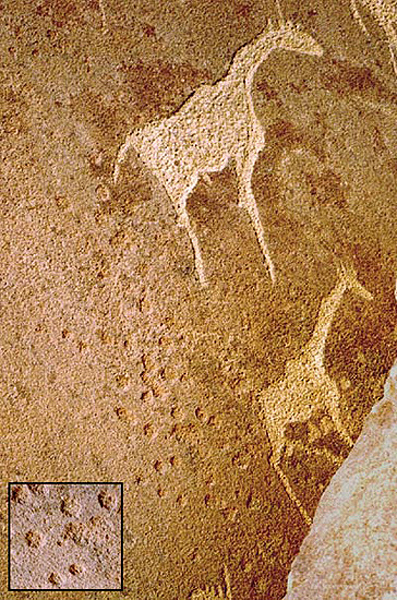 |
 |
TWYFELFONTEIN CUPULES |
7/8 |
| |
|
1.4: Inventory of Twyfelfontein Cupules (4) |
SITE 4.13: On the gravel slope below the southern habitation plain is a large boulder with the faint remains of animal engravings. Better preserved is an engraving of an oryx that is exceptional not only for having extremely large hooves (shown in plan view, to indicate them as spoor) on its two legs, but also for the four small cupules that apparently have been arranged just above each spoor and at both sides of its legs (
Figure 27 A). The meaning of this striking arrangement is not clear. However, a similar "cupule" oryx is found at site 4.15, strengthening the impression that both the arrangement and the association with oryx are intentional. This does not mean, however, that these cupules are contemporary; they may well be later (though most probably not earlier).
SITE 4.14: Opposite the well-known painting of the "walking human" in the shelter on the southern habitation plain is a vertical wall that is covered with delicately engraved figures of animals. Partially superimposing an animal are two distinct rows of small cupules. The upper row comprises 12 cupules and the lower row 10 cupules. What Scherz did not record however is a row of three, possibly five, small depressions near the bottom of the panel; two of those depressions seem to be superimposed upon a giraffe. They may be part of a (feline) spoor, especially as they seem to have claw-marks just above some of the curved row of cupule-toes (these depressions are for that reason excluded as cupules in this survey). Also not recorded previously is a row of cupules on the left-hand side of the panel, which has up to five small cupules, also possibly superimposed upon an animal. All the rows run parallel to ground level (
Figure 28).
SITE 4.15: Overlooking a small enclosure situated behind (south of) the painted shelter (and accessible through a narrow passage from the shelter) and east of the two enormous decorated blocks (D15 and D16) is a small, decorated boulder (not numbered by Scherz and therefore labelled D4d by me). On its vertical, west-facing panel are three or four animal engravings, one of which is an oryx with large spoor as hooves, while four small cupules are arranged on either side of the legs of the oryx (
Figure 27 B), just like the cupules accompanying the oryx on stone 4.13.
Just below the frieze of four ostriches on the vertical west face of the lavishly decorated boulder (D16) are two slightly curved rows of five small depressions which are said to represent a spoor of a lion. Therefore these depressions are not regarded to be true cupules.
SITE 4.16: Just below and to the right (west) of the entrance to the small plain in front of the "Carstenplatte" (G1) is a large NE sloping slab of which the lower part is covered with grooves, pecked areas and some rather indistinct animal engravings. It, however, also has some cupules, not mentioned by Scherz (1975). Near the south end is a group of possibly eight cupules of much varying sizes. They seem to enclose a small animal engraving with two rather "out of place" horns, possibly of an oryx or rather, kudu. One of the cupules has a serpentine groove that seems to be super-imposed by a ninth possible cupule (
Figure 29).
Near its centre and immediately below a ledge are three, possibly five, much worn cupules, one touching a much larger but very shallow recessed disc (
Figure 30). West of the disc is a group of two animals one of which (
Figure 30) has three extensions, each ending in a small disc or cupule. There are more small depressions on this panel that could be man made (e.g. below the faint animals).
SITE 4.17: Further south from stone 4.16 is a large cube-shaped block (the largest block in
Figure 30) occupying the centre of the small enclosure in front of the "Carstenplatte". On a west facing vertical panel are two rather distinct giraffes and the some much-weathered remains of other animals. Near the centre of the west facing panel is a group of thin lines together forming a cigar-shape parallel to ground level. This form is associated with eight possible cupules, one actually (but incidentally?) forming the head of a bird (ostrich?) engraving (
Figure 31).
SITE 4.18: This is the "Carstenplatte", a large part of which is covered with beautiful animal engravings. Near the centre of the panel is a relatively very small indeterminable animal that has been superficially pecked out.
Figure 33
Click for Enlargement
It has two legs. Its rather thicker back leg seems to have a small cupule attached to it and is therefore also somewhat longer. The cupule definitely is deeper than the rest of the animal but has the same patination (
Figure 32). It is uncertain whether the cupule is contemporary.
Near its east side, among some animal engravings, is a vertical belt of small and shallow depressions, many of which look like weathered cupules (
Figure 33). One giraffe seems to have been carved over a part of this group, possibly obliterating some of the depressions. The "cupules" have a patination that is similar to the stone and, if indeed of anthropic origin, they just possibly are older than the lighter patinated animal engravings.
SITE 4.19: Much lower down the rocky slope is another small plain overlooked by a large vertical rock face (H23) featuring two very large spoor (of rhinoceros? - see
Figure 93). Near its west edge are two cup-and-ring designs with a rather shallow central cupule each (not mentioned by Scherz). Immediately above these cup-and-rings is a pair of feline spoor that uses small cupules for toes (
Figure 34). Spoor "B" is interesting as it has seven toes and above four or five of the toes are single dots - the claw marks? - compare with the marks on stone B7 (see site 4.2) and 4.14. To the left of spoor "A" are three single cupules arranged in a triangle, reminding us of the arrangement at stone 4.4, but most likely these three have been "randomly" executed. On this rock panel are possibly twelve more much weathered shallow depressions that could be cupules.
The relative chronology of the rock-art elements on panel 4.19 is rather obscure. Especially many of the geometric designs are heavily patinated, whereas others seem to have been reworked. But in general the animals and spoor look younger and in some cases seem to have been superimposed upon much older (geometric) grooves.
SITE 4.20: Situated still lower down, almost in the riverbed (which is unrecognisable in the dry season), is a large broken boulder. Its slightly west sloping, flat upper surface features some animal engravings, but also geometric designs and at least 13 cupules. Some of the cupules are enclosed by ringmarks, which may point to contemporaneity. The cupules and geometric designs are distributed apparently randomly across the cracked panel, whereas the surviving animal figures all have been arranged along its west edge, except for some indeterminate grooves and a giraffe, the head of which is discernible along the north edge (to the right of inset 2 in
Figure 35), its neck only hardly visible.
One configuration is particularly interesting. Near the west edge is the engraving of an oryx that seems to be superimposed by two parallel grooves that connect two cup-and-ring designs (inset 2 in
Figure 35). These parallel grooves are slightly lighter patinated than the oryx and this may indicate that the geometric design is later, but it equally may have been reworked.
This is one of the very few stones at Twyfelfontein, where we find geometric and iconic designs together with cupules. Possibly they have been executed by different cultures. Based on the general assumption that geometric art involving cupules and circular motifs is earlier than animal imagery, I suggest that also at panel 4.20 the animal engravings are younger. However, there are so many different degrees of patination concerning the different graphic elements and of the natural surface of the stone that it is actually impossible to establish with certainty a relative chronology for all rock-art elements on this panel. Scherz (1975: 196) also acknowledges that only the edges still show the "original" bluish patination, whereas the centre is much smoother and more yellow/brown of colour. Scherz suggests that food had been ground on the central part of this stone (which apparently split afterwards). The grinding obliterated most of the engravings (inset 1 in
Figure 35). Also notice that the edges have also been (naturally or culturally?) flaked. This is one of the most interesting cupule stones in the area.
SITE 4.21.1: This stone (
Figure 36, see also
Figure 95) could not be located during our survey. We asked several of the guides, explaining what should be engraved on the rock, but they either did not know the stone, or took us to the "Springbockplatte" (F12 -
Figure 89), where indeed several feline spoor have been engraved, but no true cupules. Although Scherz' book includes a good photograph of panel 4.21.1, it only shows 28 of a group of actually 31 cupules. The 31 cupules are all situated on the lower part of the rock below feline and kudu spoor.
Sven Ouzman surveyed the site in March 2002. He was so kind as to confirm the approximate location of sites 4.21.1 and 4.21.2 on the map (Figure 14). He describes this panel as follows. On the outside of the overhang and at the entrance to the smallest part of the tunnel (Figure 95) is a vertical rock face with a 750mm x 700mm engraved cluster comprising 11 feline spoor, two antelope spoor and 31 cupules. The cupules measure between 16mm – 35mm in diameter and between 4mm – 11mm deep. The spoor are all engraved in pecked-infill and vary from 55mm x 40mm in size to 80mm x 75mm. Two of the feline spoor are shown with claws extended. On the outer face of the rock block there are 3 faded human figures in red paint representing a Bushman rock painting episode (Ouzman 2002).
Figure 36 clearly shows the difference in patination between the darker cupules and the lighter spoor, which may indicate a time lapse between the execution of the cupules and the (possibly later) spoor.
SITE 4.21.2: This site, just outside of the main declared monument area, is named the Grosser Malereiblock by Scherz. According to Ouzman it is located on the 640m contour and comprises a large overhang making for a cave-like space up to 2m deep and up to 3m high on a large rock block with a sloping and reasonably extensive floor area. This cave-like overhang is sited next to large upstanding rock block complex.
On the south wall Ouzman (2002) reports possible cupules: Just outside the painted shelter are four pecked-infill engraved spoor – one antelope, two equid and a horseshoe-like spoor, probably also zebra. There are two other pecked areas. Less than 10m from the paintings there are five more spoor associated with little dots/cupules (numbers not stated).
SITE 4.22 and SITE 4.23: Like stone 4.21.1, these two rocks could not be found by us on several occasions, although stone 4.23 could be located by Sven Ouzman in March 2002. Its position on the map (
Figure 14) is therefore approximately correct.
Scherz records seven "Punktkreise" at site 4.22 (C6c) and one "Punktkreis" on 4.23 (C2), but in both cases there is no special mention of "Löcher" (holes) or "Näpfchen" (cupules) in his description. There could be more cupules on such rocks, as is the case with stones 4.2 and 4.20, but they may also be absent like at panel B7. It also must be noted here that many "Punktkreise", as recorded by Scherz, do not have a true cupule at their centre, but instead a superficially executed dot or just a pecked area.
SITE 5.1: On the plateau (which is not at all flat) and directly above Twyfelfontein site 4 are two simple engraved sites (marked 5 in
Figure 2). The westernmost of these sites (K3) includes a flat-topped boulder with seven depressions. According to Scherz these most probably are grinding hollows (1975: 198, Tafel 159.2).
However, the four largest depressions are said to measure (depth/diameter): 72/82, 60/73, 57/65 and 56/57mm. Therefore, these depressions could represent large cupules, especially the smaller examples. However, as this site was not visited, neither by us nor by Sven Ouzman, these seven depressions are not included as cupules in this survey.
→
A Survey into the Relationship between
Animal-Engravings & Cupules
→
The Rock Art of Twyfelfontein
→
The Rock Art of Namibia
→
The African Rock Art Archive
→
Bradshaw Foundation
Like us on Facebook & Follow us on Twitter to receive news & updates:










